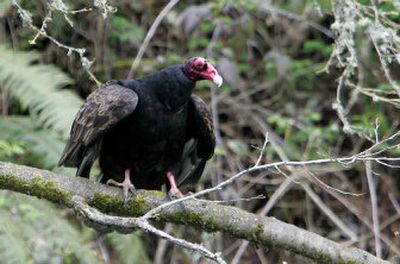Volunteers monitor river’s health

EUGENE, Ore. – Two mergansers – sleek white bodies and dark heads – skimmed the surface of the Willamette River as Barbara May put her drift boat into the water.
It was a cloudy midweek morning, but May was confident there would be no rain. There would be birds, though, plenty of them on this six-mile stretch of the river.
“You won’t see one heron nest, you’ll see lots,” she said as she angled her boat into a side channel.
To say nothing of bald eagles, red-tailed hawks, osprey, turkey vultures, various ducks, flickers, nuthatches, swallows, and if we were lucky, the odd beaver, mink or river otter.
May rows this stretch of the river at least once a month in her volunteer job as a river guardian for Willamette Riverkeeper, a nonprofit organization devoted to the well-being of the waterway.
Willamette Riverkeeper volunteers have been observing the river in the Eugene area for years, adopting sections of it to monitor for excessive erosion, new clearings, illegal dumping, sewer overflows and other problems.
Riverkeeper started a water quality monitoring program in 2003, selecting monitoring sites in conjunction with the state Department of Environmental Quality so it wouldn’t duplicate work already being done by government agencies, said Travis Williams, executive director of the Portland-based organization. Volunteers test water for temperature, turbidity, dissolved oxygen and E.coli concentration.
The program is open to experienced boaters and neophytes, too. For those who aren’t comfortable in a canoe or drift boat, the monitoring can be done from the river bank, said Williams.
The goal is to create a database of water conditions that can be published as an annual report to help governments and community members get a better picture of the condition of the river in specific locations.
Just as important as gathering the information is getting more people involved, Williams said.
“The one thing that it really does is it connects people to the river that are not otherwise connected. It provides a pathway for those that have an interest but are uncertain how to channel that interest,” he said.
Some volunteers are just beginning their relationship with the river. Others have been out on the water for years.
An experienced boater and retired University of Oregon professor, May knows this stretch of the Willamette the way most of us know our commute to work.
She can tell just where along a side channel native yellow irises will make an appearance in early May. She knows the stretch where gangs of great blue herons nest in nearby cottonwoods.
She can point to a little backwater where she once caught (and released) a 15-inch cutthroat trout. Given half a chance, she’ll haul out on a gravel bar to scuff through the river rock looking for jasper, agates and petrified wood.
May files an electronic report each month after rowing her stretch of the river from the Whitely Boat Ramp at River Mile 175.5 to Marshall Island access at River Mile 169.
Her recent reports document the impact of the rainy season’s floods, which have left their mark.
Previously open channels are now blocked by downed trees with massive root balls sticking up above the water – potential hazards that could snare boaters. Piles of logs have been thrown up on one bank, while another is scoured clean of debris.
In some places, the river has pulled out riprap, the big boulders some landowners use to stymie erosion.
May takes note of it all. Sometimes she has the chance to talk with landowners. When it comes to erosion, for example, there are more environmentally friendly methods than riprap that can be employed and even some grant money to help pay for them, and it’s the kind of information May is happy to share.
“Riverkeeper has a special niche.” she said. “And part of it is working with people who have a stake in the river.”
May delights in the little as well as the big things she sees. Among her most memorable moments: the sight of a tiny nuthatch zinging past her and drilling straight into a tree hole without so much as a pause, or the time she watched an eagle feed a fish to its young nesting in the crotch of a cottonwood tree.
An osprey perched on a snag, the wide slow wingbeats of a great blue heron in flight, the hulking shoulders of a vulture in a cottonwood, all catch her eye.
And she listens, too, for the unexpected rumble of turbulent water, for the quiet, bacon-frying sound of small gravel tumbling somewhere beneath the boat, for the trilling call of a flicker, or a nearby couple in a drift boat who want to talk trout.
Being on the river is transformative, she said.
“It’s lyrical, it’s a metaphor for everything you meet in life, the riffles, the rapids, the downed logs. The river is always there, but it’s always changing,” she said.